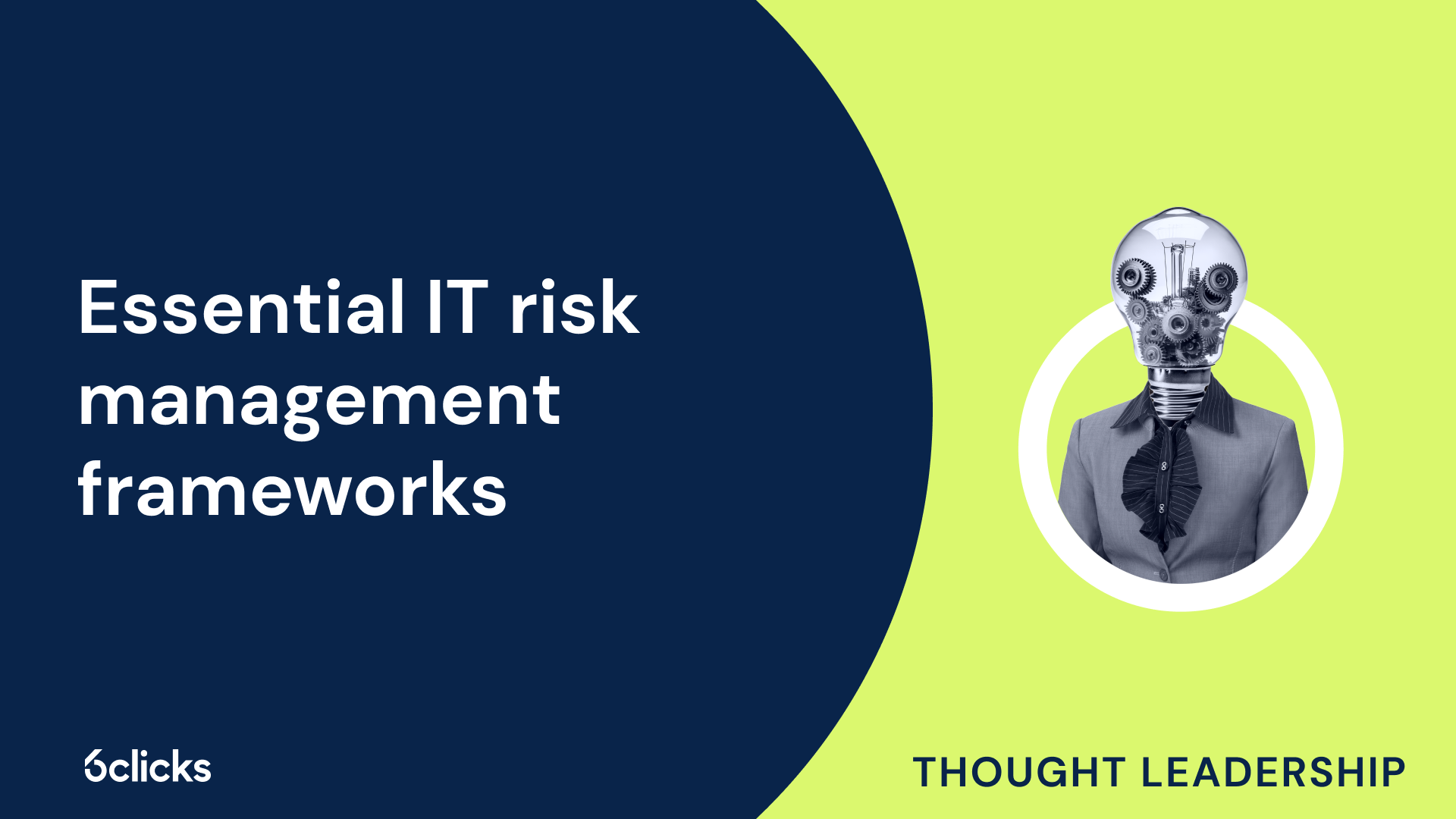In the dynamic landscape of information technology (IT), businesses face a myriad of risks that can compromise the integrity, confidentiality, and availability of their data and systems. To effectively mitigate these risks, organizations must adopt IT risk management frameworks that provide structured approaches for identifying, assessing, and mitigating IT-related risks. In this article, we will discuss the top IT risk management frameworks that organizations can use along with 6clicks’ IT Risk Management solution to enhance resilience and ensure business continuity.
What is IT risk management?
IT risk management encompasses the processes and methodologies used by organizations to identify, assess, and mitigate risks associated with their IT systems and infrastructure. It involves evaluating potential threats, vulnerabilities, and impacts on the confidentiality, integrity, and availability of information assets. This means preventing unauthorized access to private information, preserving the quality and reliability of data stored and processed by the organization, and ensuring data can be readily retrieved when necessary. By proactively addressing the risks to their data and assets, organizations can uphold information security, maintain operational continuity, achieve regulatory compliance, and improve stakeholder trust.
What are IT risk management frameworks?
IT risk management frameworks serve as essential tools for organizations to navigate the complex landscape of IT risks effectively. These frameworks offer structured guidelines and best practices for assessing and addressing various types of risks, including cybersecurity threats, compliance breaches, and operational disruptions. By adopting a framework tailored to their specific needs and industry regulations, organizations can streamline risk management processes, allocate resources efficiently, and mitigate potential threats in a systematic manner.
Importance of IT risk management frameworks
Adopting an IT risk management framework offers numerous benefits for organizations, including:
- Enhanced security: By implementing robust controls and safeguards, organizations can protect their information assets from unauthorized access, disclosure, or alteration
- Regulatory compliance: Compliance with industry standards and regulations, such as GDPR and HIPAA, helps organizations avoid costly fines and penalties while maintaining stakeholder trust
- Improved resilience: By proactively identifying and mitigating IT risks, organizations can enhance their resilience to cyber threats, operational disruptions, and other security incidents
- Cost savings: Effective risk management can help organizations avoid the financial impact of security breaches, including remediation costs, legal expenses, and reputational damage
- Business continuity: By ensuring the availability of critical systems and data, organizations can minimize downtime and maintain business continuity in the event of a security incident or disaster
Top IT risk management frameworks
Several established frameworks provide comprehensive methodologies for managing IT risks. Among the most widely recognized are:

NIST CSF and NIST SP 800-53
The National Institute of Standards and Technology’s Cybersecurity Framework (NIST CSF) offers a risk-based approach to cybersecurity using six core functions: Govern, Identify, Protect, Detect, Respond, and Recover. Organizations can use the framework to assess their current cybersecurity posture, identify gaps, and implement measures to mitigate risks effectively.
On the other hand, the NIST Special Publication 800-53 is a set of standards that specifies security and privacy controls for government agencies and service providers dealing with federal information. It is designed to meet the requirements of the Federal Information Security Management Act (FISMA) and strengthen the security of information systems within the US government.
Developed by the International Organization for Standardization, ISO 27001 is a framework for building Information Security Management Systems (ISMS). It provides requirements and controls for managing sensitive information, ensuring its confidentiality, integrity, and availability. By implementing ISO 27001, organizations can establish robust security controls, conduct risk assessments, and develop policies and procedures to safeguard their information assets.
Meanwhile, ISO 27002 is a complementary standard to ISO 27001 that provides comprehensive guidelines and control objectives focusing on cybersecurity, such as access control and incident response. Compliance with both ISO 27001 and ISO 27002 demonstrates a commitment to maintaining the highest standards of information security and regulatory compliance.
The System and Organization Controls Type 2 (SOC 2) by the American Institute of Certified Public Accountants (AICPA) is a cybersecurity compliance framework that provides requirements for managing information security based on five Trust Service criteria: Security, Availability, Confidentiality, Privacy, and Processing Integrity. SOC 2 is a minimum requirement for service providers storing and processing customer data. Compliance can be achieved by going through an external audit with a licensed CPA agency to verify the operational effectiveness of controls and systems in place.
Organizations and service providers working with the US Department of Defense must be accredited under the Cybersecurity Maturity Model Certification (CMMC) program to ensure the protection of federal information and sensitive data against diverse cyber threats. The CMMC framework guides the implementation of security controls across three maturity levels, integrating requirements from NIST SP 800-171 and NIST SP 800-172. To become CMMC-compliant, contractors to the US government must undergo a self-assessment and third-party assessment with an authorized assessor.
EBIOS
Lastly, EBIOS or the Expression des Besoins et Identification des Objectifs de Sécurité (Expression of Needs and Identification of Security Objectives) by the French government is a method for analyzing, treating, and managing information security risks. It is mainly implemented by government agencies to establish an information security system and strategy.
Implementing an IT risk management framework
Effective implementation of an IT risk management framework requires a coordinated effort across all levels of the organization. Key steps include:

- Selecting a framework: When choosing an IT risk management framework, organizations should consider various factors, including their industry sector, regulatory requirements, and risk tolerance
- Establishing leadership commitment: Senior management should demonstrate a commitment to risk management by providing adequate resources, support, and oversight
- Risk assessment: Conduct a comprehensive assessment of IT risks, considering potential threats, vulnerabilities, and impacts on business operations
- Control implementation: Implement appropriate controls and procedures to mitigate identified risks, following the guidelines outlined in your chosen framework
- Monitoring and review: Continuously monitor and review the effectiveness of risk management measures, making adjustments as necessary to address emerging threats and changing business requirements
- Continuous improvement: Foster a culture of continuous improvement by soliciting feedback, conducting regular audits, and staying abreast of evolving cybersecurity trends and best practices







